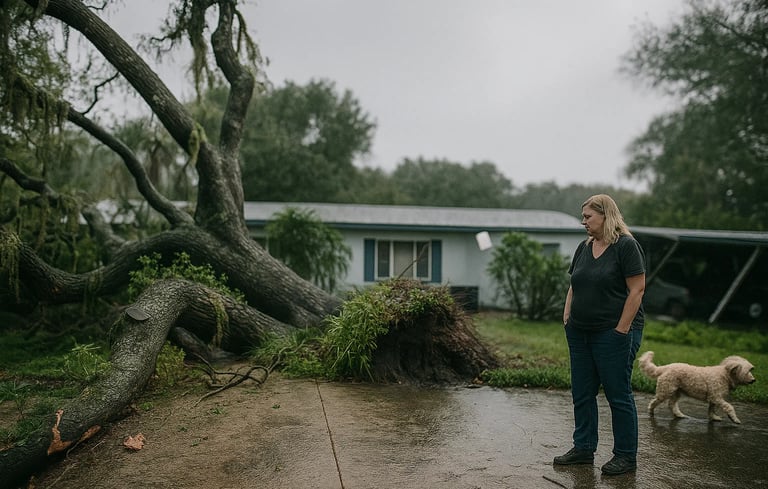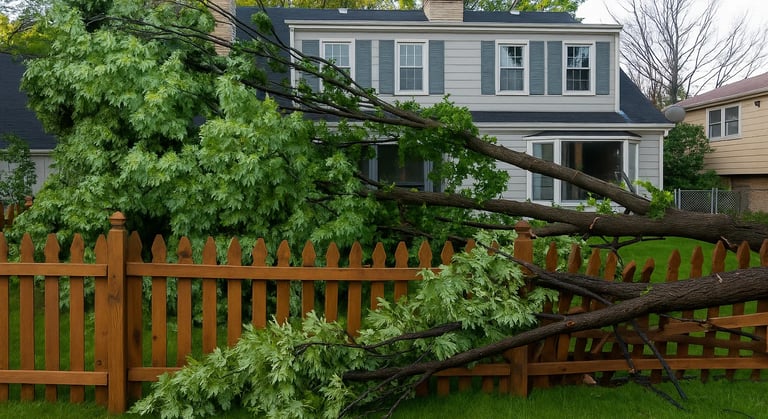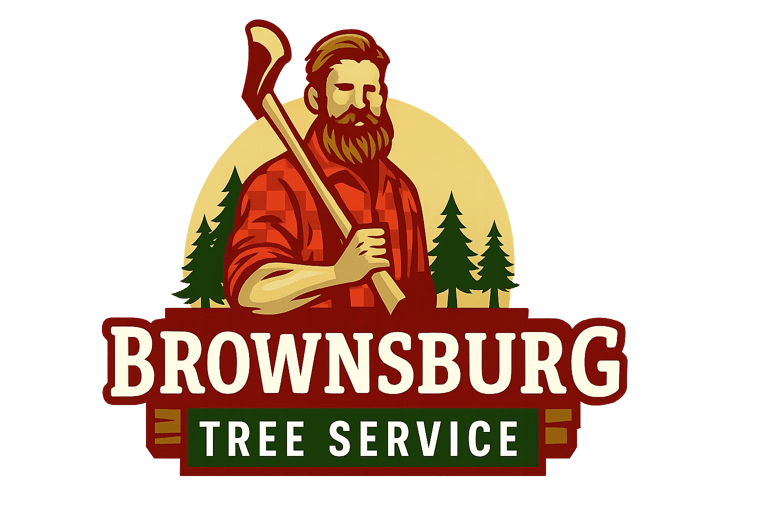Brownsburg Storm Damage
Storm Damage in Brownsburg, Indiana
Get Your Free Quote Today


Here in Brownsburg, we know a thing or two about the unexpected. One minute it's a beautiful sunny day, and the next, a storm rolls in, leaving behind a trail of unexpected surprises – especially when it comes to our beloved trees.
Storm damage can be a real headache for homeowners, turning your yard into a chaotic mess and sometimes even posing a danger to your home and family.
We've all seen the aftermath, whether it's a fallen branch blocking the driveway or an entire tree uprooted, threatening to cause serious damage.
That's why we at Brownsburg Tree Service are here to help you navigate these challenging times. We understand the unique concerns our community faces when severe weather strikes, from sudden summer thunderstorms to winter's icy grip.
Our goal is to be a reliable and friendly resource for our neighbors, providing peace of mind when Mother Nature throws her worst our way.


How do trees protect your home during a storm?
Trees, while beautiful and often providing welcome shade, can become a real liability during a storm. Instead of protecting your home, weakened or diseased trees can actually become projectiles or fall directly onto your house, causing significant damage to roofs, windows, and even the foundation.
High winds and heavy rain can weaken branches and roots, making them susceptible to breaking or uprooting entirely. It’s a common misconception that a large tree will always stand strong, but even the mightiest oak can succumb to the forces of nature if it's not healthy or properly maintained.
It's not just about direct impacts either. Falling branches can take out power lines, leading to outages and further inconvenience. The sheer weight of ice or snow accumulating on branches can also cause them to snap, even without strong winds. Understanding these risks is the first step in being prepared and protecting your property from the potential havoc a storm can wreak.
What is the most common type of storm damage to trees?
The most common type of storm damage we see here in Brownsburg is broken or fractured branches. High winds are often the culprit, twisting and snapping limbs, sometimes sending them flying.
Another frequent issue is uprooted trees, especially after heavy rains have saturated the soil, making it easier for strong gusts to pull the entire tree from the ground. This can be incredibly destructive, as the root ball can bring up large sections of your lawn and even sidewalks.
Beyond these, we also deal with split trunks, where the main stem of a tree splits lengthwise, often due to strong winds or the weight of ice. This kind of damage can be particularly dangerous as it compromises the entire tree's stability. While seemingly less dramatic, torn bark and extensive defoliation from hail or wind can also weaken a tree, making it more susceptible to disease or future storm damage.
How do you assess tree damage after a storm?
Assessing tree damage after a storm can be tricky, and it's always best to err on the side of caution and call in the professionals. However, there are some things you can look for from a safe distance.
First, check for any leaning trees, especially if they are leaning towards your home or power lines. Also, look for large, broken branches that are still hanging in the tree; these are often called "widowmakers" because they can fall unexpectedly.
It's also important to inspect the base of the tree for any cracks or heaving in the soil around the roots, which could indicate the tree is becoming unstable. Don't forget to look up and around for downed power lines – if you see any, stay far away and call the power company immediately. Taking pictures of the damage can also be helpful for insurance purposes. Remember, safety first!
Check for leaning trees or trees with significant cracks in the trunk.
Look for large, broken branches tangled in the canopy.
Inspect the ground around the tree's base for disturbed soil or exposed roots.
Note any contact with power lines.
How do you repair storm damaged trees?
Repairing storm-damaged trees really depends on the extent and type of damage. For minor issues like small broken branches, we might simply prune them back cleanly to prevent further tearing and promote healing. For larger, more significant breaks, we carefully remove the damaged sections using specialized techniques to ensure the tree's long-term health and safety.
It's not just about cutting off the broken part; it's about making the right cuts in the right places to encourage proper wound closure.
Sometimes, a tree might have a split trunk that can be saved through cabling or bracing, where we use strong cables or rods to support weak limbs or split trunks. This helps stabilize the tree and prevent further splitting.
However, in cases of severe damage, such as a tree that's been largely uprooted or has suffered extensive trunk damage, removal might be the safest and most practical option. Our goal is always to restore your tree if possible, but safety is our top priority.
Can a tree recover from storm damage?
Absolutely, many trees can recover from storm damage, especially with the right care and attention from experts. It really depends on how severe the damage is and the overall health of the tree before the storm hit.
Trees that were healthy and vibrant before a storm tend to have a much better chance of recovery than those that were already stressed or diseased. Even if a tree loses a significant portion of its canopy, it can often regenerate new growth.
However, some damage is just too extensive for a tree to bounce back from. For example, if the main trunk is completely split or if more than half of the crown is lost, the tree might be too compromised to ever fully recover its stability or health.
In those cases, removal becomes necessary to prevent future hazards. We always assess each situation carefully to determine the best course of action for your tree and your property.
How long does it take for a tree to recover from storm damage?
The recovery time for a tree after storm damage can vary a lot, just like how long it takes for a person to heal from an injury. It really depends on the type of tree, its age, and the extent of the damage it suffered. Minor damage, like a few broken branches, might see the tree recover fully within a year or two, with new growth filling in the gaps. You might start seeing significant new growth within the first growing season after the damage occurred.
However, for more severe damage, like a large section of the canopy being lost or a significant trunk injury, the recovery process can take many years. A tree that experienced a major limb failure might spend 3-5 years regaining its shape and vigor. During this time, ongoing care, like proper pruning and monitoring for disease, is really important to help the tree along. Just remember, nature takes its time, and so do trees!
When should you remove a storm damaged tree?
Knowing when to remove a storm-damaged tree is crucial for safety and preventing further property damage. We generally recommend removal if the tree is leaning precariously towards your home, other structures, or power lines.
If the trunk has a major split that compromises its structural integrity, or if more than 50% of the tree's crown is gone, it's usually beyond saving and becomes a hazard. According to the National Storm Damage Center, about 40% of trees that sustain significant structural damage during a storm ultimately need to be removed for safety reasons.
Another sign that removal is necessary is if the tree is hollow or extensively decayed, as this weakens its ability to withstand future storms. If large branches are still hanging dangerously, or if the tree is blocking essential access points, it might also be a candidate for removal.
After removal, we can also handle stump removal and grinding to ensure your yard is clear and ready for whatever comes next, preventing unsightly hazards or new growth. Our team can help you make this difficult decision, always prioritizing the safety of your family and property.
What are the signs of a diseased or weak tree after a storm?
After a storm, it's important to keep an eye out for signs that a tree might be diseased or weakened, even if it didn't suffer immediate visible damage. One common sign is a sudden wilting or yellowing of leaves that isn't due to drought.
You might also notice a significant amount of dead branches appearing in the canopy over the weeks following the storm. These could be indicators that the storm stressed an already compromised tree.
Look for unusual growths, fungal bodies (like mushrooms) on the trunk or branches, or areas where the bark is peeling or discolored. Excessive sap oozing from the trunk can also be a sign of internal issues. Sometimes, you might even notice a change in the tree's lean or stability over time.
These subtle signs often point to underlying problems that the storm might have exacerbated, and they warrant a professional assessment. Around 15% of trees that appear to survive a storm might later show signs of disease or weakness directly attributable to storm-related stress.
What is emergency tree removal?
Emergency tree removal is exactly what it sounds like – when a storm-damaged tree poses an immediate threat to life or property and needs to be removed right away. This often happens after severe weather events when a tree has fallen on a house, is blocking a road, or is precariously balancing and could fall at any moment. It's a high-priority service because waiting can lead to more damage, injury, or even fatalities.
When we talk about emergency removal, we're dealing with very dangerous situations, often involving complex rigging and specialized equipment to safely remove large, unstable sections of the tree. Our team is trained and equipped to handle these critical situations promptly and efficiently, ensuring the area is made safe as quickly as possible. We understand the urgency and stress that comes with these scenarios, and we're here to provide immediate relief.
When storm damage strikes here in Brownsburg, Indiana, it can feel overwhelming, but you don't have to face it alone. We at Brownsburg Tree Service are your neighbors, and we understand the challenges and concerns that come with damaged trees. We are committed to helping our community recover safely and efficiently from the aftermath of a storm.
From emergency removals to careful pruning for recovery, we're here to ensure your property is safe and beautiful once again. Don't let storm damage add to your worries; let us take care of the heavy lifting.
